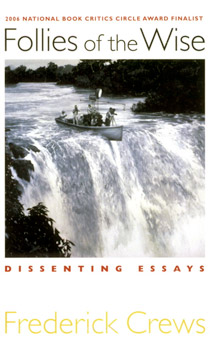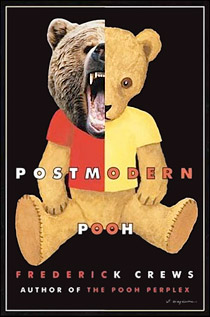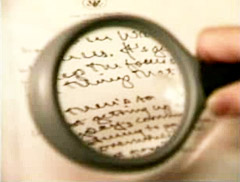Michael Shermer on
The Colbert Report
Being interviewed (if that’s what you can call it) by the inimitable Stephen Colbert was one of the wilder experiences of my career. I would imagine by now that most readers of eSkeptic know that Comedy Central’s hit series The Colbert Report features the comedian Stephen Colbert playing a role that is largely a parody of Bill O’Reilly and The O’Reilly Factor. Exaggerating the extremes of the conservative position on nearly everything, Colbert gets in his hilarious digs by arguing against liberals and liberalism. Well, words don’t do the show justice. You just have to see it. Anyway, I was on last Tuesday night. The show is taped in New York. Stephen was good enough to come by the green room (they’re never green, by the way) to introduce himself and explain, “You know, I play a complete idiot on the show, so just try to debunk me like you would any idiot.” (This introduction was very unusual. I’ve been on Larry King, Bill Maher, Oprah, and Dennis Miller, all several times each, and never once have any of them ever spoken to me before or after the show. The funniest was the first time I was on Dennis Miller’s show — I didn’t see him in person until they plopped me in the chair next to him during a commercial break, and when the cameras started rolling he turned to me and said “Sherms! How you doin’?”, like we were old pals going way back.) After Stephen left, the producer came in to review about a dozen questions that Stephen might ask, emphasizing that he might not ask any of them, or that he might start with the first one and then just wing it. That’s exactly what happened. The first question asked me to prove that I was the publisher of Skeptic magazine, and we were off and running from there, as you’ll see in this clip. It was also one of the more difficult interviews I’ve done as he is quite verbally facile, aggressive, and so damn funny that it was hard to stop laughing and try to get in just a couple of points. At least I didn’t throw water on him, which Richard Branson did the next night, another clip well worth watching (they are available on Comedy Central’s web page).
In this week’s eSkeptic Jonathan Gottschall reviews Frederick Crews’ book Follies of the Wise: Dissenting Essays (Shoemaker & Hoard, 2006, ISBN 1593761503).
Jonathan Gottschall teaches English at Washington and Jefferson College in Washington, PA. He is co-editor, with David Sloan Wilson, of the Literary Animal: Evolution and the Nature of Narrative, and he is the author of The Rape of Troy: Evolution, Violence, and the World of Homer.

Follies of the Wise (detail of cover)
Burn Down the Thinkeries!
a book review by Jonathan Gottschall
If the Greek playwright Aristophanes were alive today, he would be an active member of the Skeptics Society. His comic masterpiece, The Clouds, is a devastating satirical treatment of the Sophistical movement in 5th century Athens. In the play, Athens is beset by intellectual plagues — lies, pseudoscience, chicanery — all emanating from the Sophists’ Thinkery (Phrontisterion). The Thinkery’s guru, Socrates, hangs in a wicker basket from the rafters and, for a fee, instructs students in philosophy, science (including the thought processes of lettuce), and above all the verbal arts of “logic chopping” and “hair splitting.” (It is important to note that Aristophanes’ portrayal of Socrates as an arch-Sophist gives classicists fits. The characterization is quite at odds with the more “official” accounts of Plato and Xenophon). The Sophistical Thinkery can take almost any ambitious young scoundrel and teach him to seem right in any argument, no matter how wrong. The play ends with an ex-student, who has come to understand the institution’s true nature, setting fire to the Thinkery and inciting his fellow citizens to drive the sooty knaves from town with stones.
In his new collection of essays, Follies of the Wise, Frederick Crews performs a similar public service, figuratively speaking: he sets fire to corrupted Thinkeries. The characteristics of what I am calling a Thinkery are all on display in the skeptical critiques collected in Follies: Thinkeries display “most of the features that characterize religious fanaticism, such as undue deference to authority, hostility toward dissenters, and, most basically, an assumption that intuitively held certitude is somehow more precious and profound than the hard-won gains of trial and error”; they have a ruinous penchant for guruism and question-begging, and little regard for the basic lessons of Reasoning 101: “The proper way to assess any theory” is not simply to search out evidence for it, but to “weigh its explanatory advantages against those of every extant rival.” Most importantly, what distinguishes an authentic Thinkery from run of the mill nonsense is that its manufactures will strike most intelligent people as respectable. Thinkeries are staffed by smart people with advanced degrees, many of them work at elite universities, and their findings are almost always couched in a dense scienterrific vocabulary. It is because the flaws in a Thinkery’s thought products are so difficult to spot that the eighteen skeptical engagements presented in Follies — addressing intellectual movements associated with psychoanalysis, recovered memory, academic poststructuralism, intelligent design, and more — are so valuable.

Follies is a collection of previously published writings, most review-essays that originally appeared in The New York Review of Books. It opens with Crews’s most celebrated and notorious essays that made his name practically synonymous with “Freud Basher” (google this term and you will see what I mean). The first two chapters of the book, along with large sections of the first eleven chapters, describe revisionist analyses of Freud that challenge the hagiographical image promoted by Freud and his devotees. This Freud — Crews calls him “the unknown Freud” — is a megalomaniac, a tireless self-promoter, a hopelessly biased and inept scientist, and a truly dangerous quack with very real victims. Take Crews’s retelling of the famous Dora case study: Dora was a young teenager being sexually hunted by an older man while her father turned a blind eye to her peril; for his part, Freud puzzled over Dora’s failures to become aroused by the man’s attentions, tracing her frigidity back — where else? — to the predictable infantile traumas. But for all of his bumbling as an investigator of the mind, Freud also had a tragic facility with language, an ability — like the Sophists in The Clouds — to make a weak and baseless claim seem compelling (to his everlasting chagrin, even Crews was once seduced by Freud’s literary charisma). Consider Crews’s gloss of one of Freud’s most famous case studies, that of the Wolf Man, Sergei Pankeev:
Freud was determined to find a primal scene to serve as the fountainhead of Pankeev’s symptoms. He made it materialize through a transparently arbitrary interpretation of a remembered dream of Pankeev’s from the suspiciously young age of four, about six or seven white wolves (actually dogs, as Freud was later compelled to admit) sitting in a tree outside his window. The wolves, Freud explained, were the parents; their whiteness meant bedclothes; their stillness meant the opposite, coital motion; their big tails signified, by the same indulgent logic, castration; daylight meant night; and all this could be traced most assuredly to a memory from age one of Pankeev’s mother and father copulating, doggy style, no fewer than three times in succession while he watched from the crib and soiled himself in horrified protest.
This is despite Pankeev’s protestations that he could not have witnessed this event: due to the customs of his social class, his crib would never have been located in his parents’ bedroom. Crews makes it clear that, far from being exceptional, the Wolf Man case is a typical foundation stone upon which the whole “ramshackle edifice” of psychoanalysis was set to wobble. And, in the first eleven chapters of Follies, he shows that Freud is still very much with us today. In chapters on the recovered memory movement, the Rorschach test, hysteria, and alien abductions, Crews shows that elementary Freudian concepts underlie them all — especially the cornerstone concept of the “recoverability” of repressed memories by canny therapeutic sleuths. The two chapters on the recovered memory movement are especially powerful, and they demonstrate one of Crews’s most effective points: “pseudoscience inevitably leads to harm.”
The first half of Follies is absorbed with psychoanalysis and its consequences. The second half is more eclectic in subject matter and a lot softer in tone. But it follows threads of illogic, question-begging, confirmation bias, and guruism that bind psychoanalysis together with other Thinkeries. Here are essays on the Theosophical movement, on the Nazis and the occult, on the brazen hypocrisy of an icon of American Buddhism, as well as disquieting reviews of scholarly trends in literary academia. The anchors of the second half, however, are two excellent essays on Darwinism and its controversies. The first, “The New Creationists and Their Friends,” is an assault on creationist Thinkeries such as the Discovery Institute. In describing recent books on both sides of the Intelligent Design controversy, Crews demonstrates the bankruptcy of the new creationism. In the second, “Darwin Goes to Sunday School,” Crews accuses fellow Darwin-defenders, including heavyweights like Stephen Jay Gould and Michael Ruse, of watering down the implications of Darwinism in their attempts to make natural selection more palatable to moderate Christians. His critique of Gould’s influential concept of NOMA (the claim that religion and science operate in absolutely distinct spheres — in Non-Overlapping Magisteria) is particularly sharp.

The collection culminates with several essays on Crews’s main target of critique after psychoanalysis: modern literary academe (Crews is retired from the English Department at Berkeley). In this final section, in an appendix on literary scholars’ embrace of pseudoscience, and in copious writings not represented in Follies (e.g., his 2001 book Postmodern Pooh, a satire of literary gaseousness), literary academe emerges as perhaps the quintessential modern Thinkery. This is because literary academe represents a protected preserve where ideas that have been hunted to the brink of extinction in other academic fields (just to name a few, Freudian and Lacanian psychoanalysis, classical Marxism, blank slate models of human nature) can survive a while longer, shielded from the spears of skeptical hunters. It is the quintessential modern Thinkery because it is a zone where the dangers of confirmation bias are hardly recognized, where political preferences often determine fact claims, where dissenters (like the liberal Crews) can be tarred as closet Republicans, and where the dogmas of gurus are paid proper obeisance.
I first heard the name Frederick Crews in a course on the dogmas of gurus. It was the mid 1990s and I was a literature graduate student enrolled in a class on psychoanalytic criticism. I was young and ignorant and, for a short time, quite taken in by the sheer ambition of Freud’s efforts (he unshamefacedly styled himself as a Darwin or Copernicus of the mind). The professor was a youngish and charismatic associate professor who seemed confident in the psychoanalytic model of the mind, and we read the works of latter day Freudians who explored, ratified, and expanded that model in their own studies. But, in point of fact, no one in our class was much concerned about the model’s empirical validity. All that mattered was that if you jammed literary works through the psychoanalytic filter, startling new “readings” always emerged at the hind end. Just once, as I recall, did the professor acknowledge that there were serious thinkers who questioned the validity of the whole psychoanalytic enterprise. He said that there were some Freud bashers out there, and he mentioned just one by name.
Before the semester’s end I was nursing dangerous heresies about psychoanalysis’s central dogma: almost everything important in psychical life has roots in the demented, murderous sex fantasies of infants. I went back to my notes, found the name Frederick Crews, and went to the library. But the author I encountered in the New York Review of Books was not who I expected: a bloody-minded basher, shaking a gory cudgel. The “basher” epithet is meant to imply that Crews is a mad vandal who glories in anarchic demolition of hard-won intellectual gains. But the author I encountered was just a skeptic, one who was graceless enough to challenge an intellectual giant and, in so doing, to threaten the interests of powerful therapeutic and academic establishments. Moreover, if Crews sometimes resorted to the cudgel his motives were basically humanitarian; Crews believed then, and believes now, that “the psychoanalytic model of the mind … is a formidable instrument for generating anguish and injustice.”
It is this humanitarian strain in Crews’s debunking that gives the essays of Follies their distinctive moral energy. The critiques are not only motivated by academic persnicketiness about violations of elementary scientific and scholarly standards; they are also motivated by wholesome emotions of pity, anger, and fear about the real harm caused to real people by Thinkeries and their manufactured thought products (in fact my one niggling criticism of Follies of the Wise is its title, which misleadingly suggests light fun at the expense of blundering but harmless fools). This is clearest in the two chapters on the recovered memory movement — “the great sex panic” that swept the nation starting in the middle 1980s, finally petering out about a decade later. Crews persuasively argues that the whole episode, with its inquisitorial fervor, with its spooky aura of Salem Village, with its thousands upon thousands of real victims (families exploded, patients afflicted with implanted delusions of horrifying ritual abuse by their loved ones, innocents railroaded into prison) was a phantasm created — not revealed — by therapists adapting psychoanalytic modes. The fire that Crews, and others, applied to the Recovered Memory Thinkery was both scourge and philanthropic gift. The same can be said for the skeptical flame illuminating all of the essays in Follies of the Wise.

Graphology, Part 1
Graphology, or handwriting analysis, claims that personality characteristics such as introversion and extraversion can be inferred from the form and structure of letters, words, and sentences (introverts, for example, are said to write in smaller letters, extraverts in larger letters). Shermer puts graphology to the experimental test. WATCH the video >










